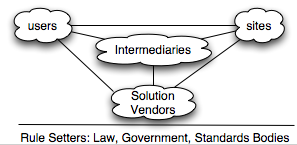At it’s heart the problem of network identity is how to manage the model of the user available to web sites. User’s dream of a design that’s explicit, practical, and respects their privacy. Web sites covet different aspects of the user-model model. The fashion web site may desire to know the user’s hair color. The travel web site may desire to know when your employeer is planning a summer shutdown. The bank site may desire to know a statement of account of your current mortgage.
The demand for better models of visitors is what drives the market for solutions in the identity market. For example it’s what keeps DoubleClick in business. DoubleClick aggregates a statistical model of users from their browsing habits and then sell that to web sites. Web sites then use that to target their marketing. For all I know if you tell one of their clients your hair color then DoubleClick may well add that to their model.
Such implicit, statistical models of users don’t scale up to handle the revealing of more serious information (i.e. medical records, mortgage statements, video rental records, etc.), because of regulatory protections. Sadly some cases these regulatory protections are no more solid than the community expectations. I would certainly make a fuss if L.L. Bean sold information about my pants size to Amazon; but I wouldn’t actually be surprised. Few of us are surprised that if you reveal your a wish list or rate a product at Amazon it effects how they customize the web site for you.
The design challenge here is how to make the management of this revealing more explict. Something that users can understand, manage, manipulate, control. Something that regulators can then write practical rules about. Something that can be governed well. Something that tempers how much power concentrates into a few hands. If such hubs are absolutely necessary we presumably want to assure they are well governed. Tough problems.
Any solution will have to respect and balance the concerns of all the market particpants. Broadly there are five roles in this passion play. In the long run none of these is weak. Users, though, tend to be slow in exercising their power.

Intermediaries get a lot of the attention here. DoubleClick, Passport, or Gator are comercial examples. These players dream of solutions that tend to concentrate the power in the market into their hands. The regulatory foundation also gets a lot of attention. That includes: standards bodies like the Liberty Alliance; pseudo-standards certification organizations like eTrust; governments (e.g. EU’s privacy regulations). The regulators tend to dream of getting a single standard to “rule them all.” They also tend to work to limit how much market concentration emerges in the roles above them.
The solution vendors, i.e. the folks that don’t actually run services but instead provide tools to those that do, may dream of owning the entire market but they are also very interested in assuring that a large number of customers for their tools survive. There a huge number of examples of in this role just to pick to random examples: the authentication tools found thru-out the open source middleware community; and Novell’s Oblex solution that is widely used inside firms. There is a notable subgroup in the solution provider space, the patent holders. Note also that standards bodies often provide a means to aggregate a patent portfolio.
Many real world examples are hybrids of these five classes. For example Yahoo, which is primarily a site, also does authentication ala Passport for some partners. These hybrids seem to have internal tensions between their roles.
Market concentration in all these catagories is, presumably, power-law distributed. For example DoubleClick and Passport are both in the top hundred traffic sites.
Interesting market, interesting design problem.